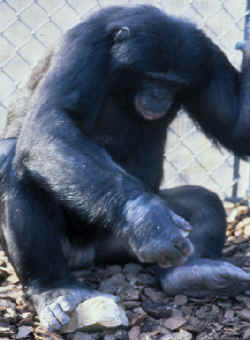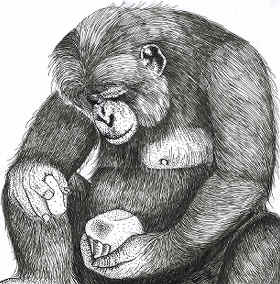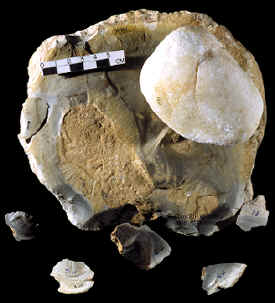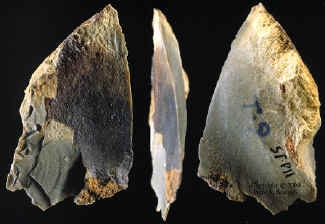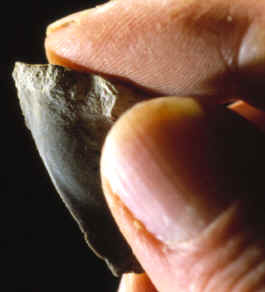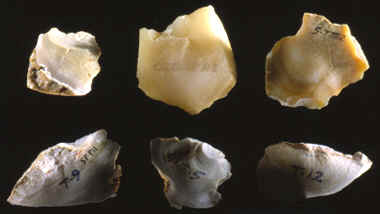|
IN THE BEGINNING THERE WAS
THE |
|
Uniface Flakes,
Choppers & Cores
STONE Tools"
Not long ago I was told an interesting story from
someone who buys painted Australian aboriginal art. While he was riding in a car
with a well known aboriginal artist a kangaroo was struck and killed. When they
stopped the car the aborigine quickly jumped out and ran to the ditch where he
searched for and found two rocks that were suitable for the job he was about to
do. He then struck the rocks together to make a stone flake and walked over to
the kangaroo where he then quickly cut off the tail with the sharp edge of the
flake. He jumped back into the car making the comment that it was a good tail or
he could use the tail or something like that. It's a great account of a spontaneous
use of a stone tool in the modern world. |
|
KANZI THE CHIMP MAKING A STONE FLAKE TOOL THAT HE WILL USE
TO OPEN A BOX OF FOOD
The most recent study of stone tool making by using apes was begun about
1990 and has continued for some years. The study was proposed by Kathy
Schick and Nick Toth of the Craft Research Center. They were able to do
the study and collaborate with E. Sue Savage-Rumbaugh, Duane Rumbaugh and
Rose Sevcik at the Language Research Center in Atlanta, Georgia where the
now famous chimpanzee known as Kanzi is kept. Previous to this project, an
Australian archaeologist Richard Wright in the 1970's was able to show
that an orangutan that lived in a local zoo could be taught to make stone
tools and cut ropes off a box containing food.
This drawing of Kanzi shows him attempting to drive off a simple flake. He will use it to cut through some rope tied around a box containing grapes or other food that he likes to eat. On research tape I have seen, when Kanzi is striking a rock with another rock (or hammer stone) he seems to strike towards his chest or stomach. His great strength actually powders and pulverizes so much rock particles onto his chest hair he will have to stop and brush it off. He does this with a striking distance of only 3 or 4 inches!
CLICK ON PICTURE
FOR VERY LARGE IMAGE
This picture
shows the simple stone tool making kit used by Kanzi. He produced these
flakes to cut through ropes that were used to tie shut boxes of food.
CLICK ON PICTURE
FOR LARGE TRIPLE EXPOSURE
This picture shows a typical flake with a sharp cutting edge that Kanzi
used to cut rope.
KANZI'S
CUTTING FLAKE
Kanzi's cutting flake shown as it would be held to cut hide, rope or
anything soft. Kanzi will hold the flake in one hand and sometimes deftly
pick apart and cut each strand of the rope with the other just as a human
might do.
SIMPLE
FLAKE CUTTING TOOLS These flakes represent the simplest and oldest type of stone tool. They are flakes of chert that have been or may have been used to cut soft materials. The top row of flakes were collected from Olduvai Gorge by Lewis Leaky & Desmond Clark and date to approximately 1.9 million years ago. The bottom row were made by Kanzi and were used to cut ropes off boxes of food. |
|
"REFERENCES" 1988,
"Encyclopedia of Human Evolution and Prehistory" Ian Tattersall,
Eric Delson and John Van Couvering, PP 387-392. |


